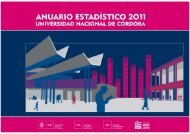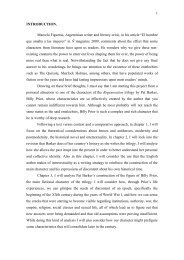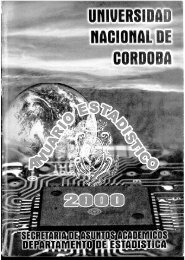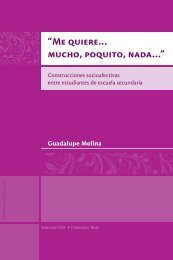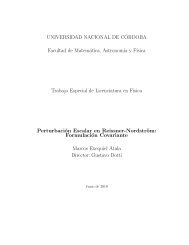Abrir - RDU - Universidad Nacional de Córdoba
Abrir - RDU - Universidad Nacional de Córdoba
Abrir - RDU - Universidad Nacional de Córdoba
You also want an ePaper? Increase the reach of your titles
YUMPU automatically turns print PDFs into web optimized ePapers that Google loves.
Abstract<br />
In this thesis we discuss some general results concerning the classification problem of finite<br />
dimensional Hopf algebras over an algebraically closed field k of characteristic zero. They are based<br />
on three articles [G], [AG], [AG2], being the first one already published.<br />
After recalling the basic <strong>de</strong>finitions and some known facts in Chapter 1, we present in Chapter 2<br />
several results on extensions of finite-dimensional Hopf algebras which will be nee<strong>de</strong>d in the chapters<br />
thereafter. Explicitly, we prove first that a Hopf algebra which is an extension of a Taft algebra<br />
T (q) of dimension p 2 by a group algebra of dimension p, with p an odd prime number and q a p-th<br />
root of unity, is necessarily pointed. Then we study central extensions of Hopf algebras and show<br />
how to construct central extensions of finite-dimensional Hopf algebras from a central extension<br />
B ↩→ A ↠ H and two epimorphisms p : B → K and r : H → L. Moreover, we <strong>de</strong>scribe un<strong>de</strong>r<br />
certain conditions the classes of isomorphisms of this type of extensions.<br />
Next we apply in Chapter 3 the obtained results to Hopf algebras H of dimension p 3 over k. There<br />
are 10 cases according to the group-like elements of H and H ∗ . We show that in 8 of the 10 cases,<br />
it is possible to <strong>de</strong>termine the structure of the Hopf algebra. We also give a partial classification of<br />
the quasitriangular Hopf algebras of dimension p 3 over k. In particular, we prove that every ribbon<br />
Hopf algebra of dimension p 3 over k is either a group algebra or a Frobenius-Lusztig kernel. Using<br />
some results from [AN] and [BD] on bounds for the dimension of the first term H 1 in the coradical<br />
filtration of H, we end Chapter 3 by giving the complete classification of the quasitriangular Hopf<br />
algebras of dimension 27.<br />
In Chapter 4 we use the construction of central extensions of finite-dimensional Hopf algebras to<br />
produce new examples of non-isomorphic Hopf algebras of the same dimension, which are another<br />
counter-example of the already negated Kaplansky 10-th conjecture: let G be a connected, simply<br />
connected complex semisimple Lie group with Lie algebra g, Cartan matrix C and symmetrized<br />
Cartan matrix CD. Let l ≥ 3 be an odd integer, relatively prime to <strong>de</strong>t CD. Given an embedding<br />
σ of a finite group Γ on G and a primitive l-th root of unity ɛ, we construct a central extension<br />
A σ of the function algebra C Γ by the dual of the Frobenius-Lusztig kernel u ɛ (g); A σ is a quotient<br />
of the quantized coordinate algebra O ɛ (G) and dim A σ = |Γ|l dim g . If G is simple and σ(Γ) is not<br />
central in G, then we obtain an infinite family of pairwise non-isomorphic Hopf algebras which<br />
are non-semisimple, non-pointed and their duals are also non-pointed. This generalizes the result<br />
obtained by E. Müller [Mu2] for SL 2 (C). Nevertheless, it follows from results in [Mk5] that these<br />
Hopf algebras are cocycle <strong>de</strong>formations of each other. We notice that the construction of such a<br />
family requires some technical preparations on the cohomology of Γ in a certain subgroup T fσ of a<br />
fixed maximal torus T of G, and the inequality<br />
dim G > rg G + dim M



